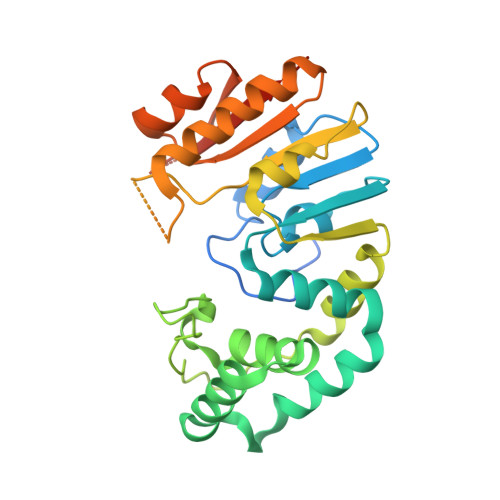Two Alternative Conformations of S-Adenosyl-L-homocysteine Bound to Escherichia coli DNA Adenine Methyltransferase and the Implication of Conformational Changes in Regulating the Catalytic Cycle.
Liebert, K., Horton, J.R., Chahar, S., Orwick, M., Cheng, X., Jeltsch, A.(2007) J Biological Chem 282: 22848-22855
- PubMed: 17545164
- DOI: https://doi.org/10.1074/jbc.M700926200
- Primary Citation of Related Structures:
2ORE - PubMed Abstract:
The crystal structure of the Escherichia coli DNA adenine methyltransferase (EcoDam) in a binary complex with the cofactor product S-adenosyl-L-homocysteine (AdoHcy) unexpectedly showed the bound AdoHcy in two alternative conformations, extended or folded. The extended conformation represents the catalytically competent conformation, identical to that of EcoDam-DNA-AdoHcy ternary complex. The folded conformation prevents catalysis, because the homocysteine moiety occupies the target Ade binding pocket. The largest difference between the binary and ternary structures is in the conformation of the N-terminal hexapeptide ((9)KWAGGK(14)). Cofactor binding leads to a strong change in the fluorescence of Trp(10), whose indole ring approaches the cofactor by 3.3A(.) Stopped-flow kinetics and AdoMet cross-linking studies indicate that the cofactor prefers binding to the enzyme after preincubation with DNA. In the presence of DNA, AdoMet binding is approximately 2-fold stronger than AdoHcy binding. In the binary complex the side chain of Lys(14) is disordered, whereas Lys(14) stabilizes the active site in the ternary complex. Fluorescence stopped-flow experiments indicate that Lys(14) is important for EcoDam binding of the extrahelical target base into the active site pocket. This suggests that the hexapeptide couples specific DNA binding (Lys(9)), AdoMet binding (Trp(10)), and insertion of the flipped target base into the active site pocket (Lys(14)).
- Biochemistry Laboratory, School of Engineering and Science, Jacobs University Bremen, 28759 Bremen, Germany.
Organizational Affiliation:


















